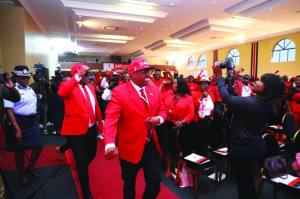As the impact of climate change continues to heighten, excessive pressure is also being exerted on livelihoods across socio-economic spheres, particularly for developing nations.
The Intergovernmental Panel on Climate Change (IPCC) Report 2023 on Climate Impacts, Adaptation and Vulnerability, drawing from 34,000 studies, involving 270 authors and 68 countries, highlights some of what is being experienced today.
Even at just 1.1 degrees of warming, the report says climate change is causing havoc in every part of the world. This includes droughts, extreme heat and flood events. Consequently, food security has come under siege and livelihoods threatened for millions of people.
The International Monetary Fund also warned in a 2023 study that climate change will worsen food insecurity in Southern Africa, “unless policies are put in place to mitigate effects”. As of the IPCC report released in March, crop production in Africa shrunk by a third due to climate change.
If there was a time the adage ‘spreading like wildfire’ was very apt, it is now. The Environmental Defence Fund demonstrates how “hotter temperatures evaporate more moisture from soil and vegetation, drying out trees, shrubs and grasses and turning leaf litter and fallen branches into kindling”.
“Wildfires are causing irreversible landscape damage in larger areas than before,” states the IPCC synthesis report, whose next reporting cycle is likely to conclude around 2030.
Last year, conflagrations gutted down grazing land and left farmers like Thabiso Kebadile of Gantsi out in the lurch. Scores of his livestock had nowhere to feed and fending for them was the only option.
The fires led to a drought. They also decreased the calving rate and caused high mortality rates, subsequently leading to serious economic losses for the farmer. The farmer was forced to dig deep into his pockets to buy supplements as the productive herd suffered from poor body condition.
Realising the adverse effects of fires farmers like Kebadile face, coupled with the impact of other climate variables on human lives and properties, Botswana and China signed a Memorandum of Understanding (MoU) in 2020. This was through their respective portfolios, being the Ministry of Environment, Natural Resources Conservation and Tourism and China’s Ministry of Ecology and Environment. The MoU was meant to strengthen efforts in research focused on designing systems that could improve resilience to climate change. The agreement entailed China gifting Botswana with a meteorological mobile station and the technology is currently being shipped to Botswana.
Kebadile, the Gantsi-based farmer, says the technology will alert the farming community well ahead of catastrophic dangers such as fire well in time, allowing them to put in place remedies to avert damage. The livestock producer, who keeps both small stock and cattle, says such a system will assist farmers plan for mechanisms such as fire breakers to avert damage to their grazing areas, as they know that there will be readily available technology to monitor fire incidents.
Wildfires are a recurrent phenomenon in Botswana. According to the Department of Forestry and Range Resources, the year 2011 had the highest incidents of veldt fire outbreaks with over 15,000,000 hectares burnt.
Head of Fire Management Resources at the department, Jomo Mafoko said the previous season was badly afflicted.
“The year 2022 we had 1,052,462 hectares burnt with Gantsi being the most affected district followed by Kgalagadi,” he said.
“Most of the fires occurred in the Central Kalahari Game Reserve (CKGR).”
An estimated 383,395 hectares were burnt in the year 2022 fire period, which runs from April 2022 to March 2023. Regarding damage to the meat production sector, Mafoko said livestock is affected because some fires occur in grazing areas, but most fires in Gantsi occur in the CKGR.The challenge, according to Mafoko, is not owning a fire detection system. The department uses data from the Fire Information for Resource Management System (FIRMS) website for active fire detection, in addition to obtaining information from the Advanced Fire Information System (AFIS) for pre-fire risk assessment.
“I hope the upcoming system will strengthen existing mechanisms through timely detection of fires, therefore, minimising damage, as well as timely assessment of damage by fires of individual fires,” he said.
“Climate change plays a major role in the changes in the fire trend or regimes.”
In the arable and crop production sector, the amount of rainfall and the time it rains, as well as temperature variations, are important variables. This necessitates timely and precise information in weather forecasts for large-scale commercial farmers such as those in the Pandamatenga area, the country’s agricultural hub. The type of farming happening in Pandamatenga, where commercial farmers contributed an annual grain production of up to 44,336 tonnes during the cropping season 2020-2021 for instance, is called dry land farming.
Lillian Scheepers, a commercial farmer and member of the Pandamatenga Commercial Farmers Association, said upon receiving a forecast of above-normal rains this season, farmers invested heavily in fertilisation in anticipation of better yield. However, she said, the opposite happened.
“We don’t know whether the tornados in the Indian Ocean affected the forecast or it is to do with the inaccuracy of the weather forecast,” she said.
It is with this backdrop that Scheepers advocates having the best meteorological instruments and information in the best way possible, explaining that using the best technology is crucial for agricultural advancement in Botswana. She believes meteorological technologies, which yield information with minimal error margin, would be phenomenal to agriculture production. Consequently, levels of production will experience positive growth.
“If we have the right information, technology and the right farming techniques, the right market price and decreased cost of production – it’s a combination of factors – we would be good because Botswana has the capacity to produce for local demand as well as outside markets,” she said.
Scheepers is optimistic that the upcoming technology will address farmers’ challenges and enhance capacity across the crop production sector, horticulture and every other component of farming.
Government has zoned Pandamatenga as an agriculture hub with opportunities for investment in cereal production, agro-processing, water management solutions as well as pesticide and fertiliser production. The 96,500-hectare agro-production zone comprises 44,500 hectares of existing commercial farming land and 12,000 hectares occupied by subsistence farmers. In recent times, 40,000 hectares have been proposed for the production of cereals like maize, sorghum, millet, wheat and barley as well as legumes like beans, chickpeas and groundnuts. The area will also have oil seeds, fruits and vegetables.
Extreme weather events and climate change, as they unfold, stand as challenges before Botswana’s aspirations of food sufficiency and security.
Department of Meteorological Services director, Chandapiwa Sebeela mentioned a host of benefits that come with a Monitoring and Analysis System (MAS) of Meteorological Satellite, key amongst them being the provision of a national operation platform for remote sensing monitoring and analysis, as well as service publishing for climate, disaster risk management and environmental management.
“For the agriculture sector, the data from the system can be used in agricultural resources survey, crop yield assessment and growth monitoring as well as drought monitoring.
“Agriculture Remote Sensing System is an integrated business system which can complete different agriculture remote sensing businesses and provide decision-making information for farmland exploitation, crop planting adjustments, food import quantity and disaster relief.
“Some of the uses under this sector are agricultural resources monitoring, grassland and rangeland monitoring as well as farmland monitoring,” said Sebeela. Climate data, science and research are of paramount importance in the climate age especially now when climate attribution is a growing and critical field. This refers to “establishing the most likely causes of detected change with some defined level of confidence” as opposed to merely citing climate change.
Sebeela regards the system as critical to providing various data sets inclusive of remotely sensed geospatial data, which would avail opportunities for advanced research, critical for closing gaps in issues related to the attribution of various climate disasters.
“Research that could lead to resolution of climate change attribution would provide added opportunities for access to climate finance since project developers would have clear information as they develop their proposals,” she added.
Africa is not a significant source of greenhouse gas emissions and only accounts for two to three percent of the world’s carbon dioxide emissions from energy and industrial sources.
However, it is the region most susceptible to the dangerous effects of climate change.
Delivering a speech at the World Leaders Summit at the 26th Session of the Conference of the Parties (COP26) to the United Nations Framework Convention on Climate Change (UNFCCC), Chinese President Xi Jinping noted that the adverse impacts of climate change have become increasingly evident, presenting a growing urgency for global action. Xi said that how to respond to climate change and revive the world economy are challenges of current times that need urgent attention.
At the shipping out ceremony of the meteorological mobile station aid from China, expected in Botswana later this year, Botswana’s Ambassador to China, Dr Comma Serema noted the system would be very instrumental in Botswana’s efforts to deal with the impacts of climate change, especially its studies and monitoring, resulting in better mitigation. Furthermore, communication from Chinese media quoted Zhao Yingmin, who is the vice minister of Ecology and Environment, as saying a multi-star integrated satellite data mobile receiving and processing application would support agricultural production and prevent extreme climate disasters in Botswana.
Thus far, China is said to have implemented more than 60 types of aid projects from 45 climate change cooperation agreements with 38 developing countries, including Botswana.
*Baboki Kayawe is an MPhil student in Natural Resources Management and Development Communication at the Okavango Research Institute and a freelance journalist. This article was produced through funding from the China-Africa Reporting Project, coordinated by the University of the Witwatersrand in South Africa







